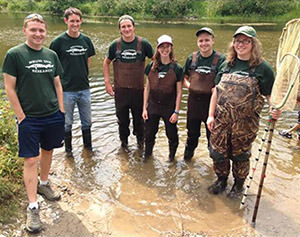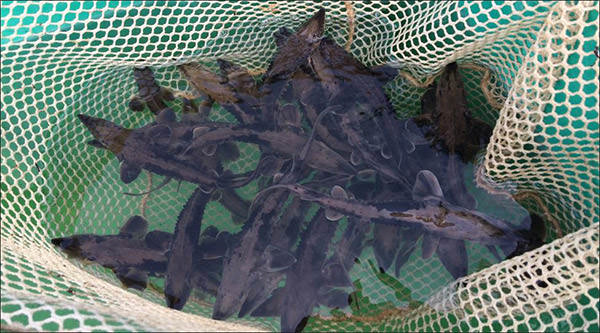2015 Sturgeon For Tomorrow Research
Lake Sturgeon Research and Stocking Summary
By John Bauman, Research Technologist, Michigan State University
- 2015 MSU research team: From left to right; Jonathan Hegna, John Bauman, Dillon Ross, Jenna Ruzich, Ryan Walquist, and Shaley Valentine. Not pictured: Adam Chastan, Justin Waraniak, and Garrett Johnson.
The 2015 Black Lake research season began April 30th when Michigan State University (MSU) and Michigan Department of Natural Resources (MDNR) researchers captured six Lake Sturgeon ascending the Upper Black River. This was a later start compared to previous years, yet the adult sampling period continued into June with the last sighting of a sturgeon in the river being recorded on June 8th.
A total of 248 adult Lake Sturgeon were captured throughout the spawning season, which includes 46 newly captured fish. The one day record of fish captured this year was 35 individuals. The largest fish captured this year was a 6 foot 3 inch female that weighed 133 pounds. In total there have been 1,037 unique individual Lake Sturgeon captured in the Upper Black River since 2001. Gametes were collected from spawning Lake Sturgeon and were transported to the Stream Side Rearing Facility for fertilization and rearing.
In addition to raising eggs in the hatchery, wild larval Lake Sturgeon were captured as they drifted downstream. Previous studies conducted by MSU and MDNR researchers found that these wild larvae represent the best stock source genetically, so all captured larvae are brought back to the Streamside Facility in an effort to enhance survival. This year, larval drift sampling began on May 19th and ran until there were two consecutive unsuccessful capture nights, which this year was on July 5th.
As a result of night sampling, researchers captured 1,723 wild dispersing larvae.
This year, Lake Sturgeon raised at the Streamside Facility and utilized for stocking were all of wild origin. In addition, to enhance future management efforts, all 529 Lake Sturgeon released into the Black River were implanted with passive integrated transponder tags. All 500 Lake Sturgeon released into Mullett Lake and 53 released into the Sturgeon River were implanted with coded wire tags.

At the end of the hatchery season Lake Sturgeon reached an average length over 7 inches prior to release which is larger than previous year’s release size. Larger growth can be attributed to improved feeding strategies developed through research activities conducted at the Black River Streamside Facility.
Ongoing research involved identifying sources of early mortality in larvae, particularly those preyed upon by fish predators (such as Rock Bass). In addition to identifying sources of larval mortality in the wild, researchers continue to focus on identifying more efficient food types for hatchery-raised Lake Sturgeon as well as continue to investigate the downstream passage of juvenile Lake Sturgeon through hydroelectric facilities.
- Migration Behavior of Spawning Adult Sturgeon in the Black River, MI (Dillon Ross)
- Effects of Alternative Food Types on Larval Lake Sturgeon (Acipenser fulvescens) Body Size and Survival (Jenna Ruzich)
- Juvenile Lake Sturgeon Downstream Passage and Survival at Two Hydroelectric Dams (Jonathan Hegna)
- Predation of larval lake sturgeon by piscine predators in the Black River, MI (Justin Waraniak)
- Aquatic macroinvertebrates affect Lake Sturgeon eggs and free embryos (Ryan Walquist)
- Effects of alternative foods on body size and survival of larval Lake Sturgeon (Shaley A. Valentine)
LTBB Burt Lake Survey and Release
The Little Traverse Bay Band of Odawa Indians (LTBB) has stocked fall fingerling sturgeon in Burt Lake since 2013.
The goal of the survey is to gather data on the survival, growth rates and other information for these stocked fish.
The Burt Lake sturgeon assessment was conducted September 14 through October 5 and targeted both juvenile and adult sturgeon. The fish were checked for tags which showed if the sturgeon were wild (no tags) or stocked. The tags provide a history of when the fish were stocked and when they might have been caught in previous surveys. The wild fish were also tagged so that they can be followed in new surveys or when they are possibly harvested in the future.
Sampling locations were randomly chosen throughout the entire lake. Three boats were used, including two tribal boats, and one DNR boat and crew. There were 63 unique sturgeon captured and 3 of these sturgeon were recaptured during this survey. In addition, 7 of the captured sturgeon were tagged during the 2011 survey. Despite the smaller mesh size, the 2015 survey did not produce many small sturgeon and provided little evidence of strong natural or stocked juvenile recruitment.
Very preliminary population projections estimate the sturgeon population of Burt Lake to be between 644 and 1535 sturgeon.
Expanded numbers should be interpreted with caution due to the low numbers captured during the survey.
- Home Page
- Black Lake
Sturgeon Shivaree - Black Lake Watershed
- Black Lake Sturgeon Management Plan
- Committees
- Contact Us
- Directors
- Events
- Habitat Conservation
- Membership
- Newsletters
- Our History
- Photo Gallery
- Research
- Resources
- Resources for Educators
- SFT Scholarships
- Spearing Guidelines
- State Regulations
- Sturgeon Guarding
- Sturgeon Hatchery
- Sturgeon in the Classroom

